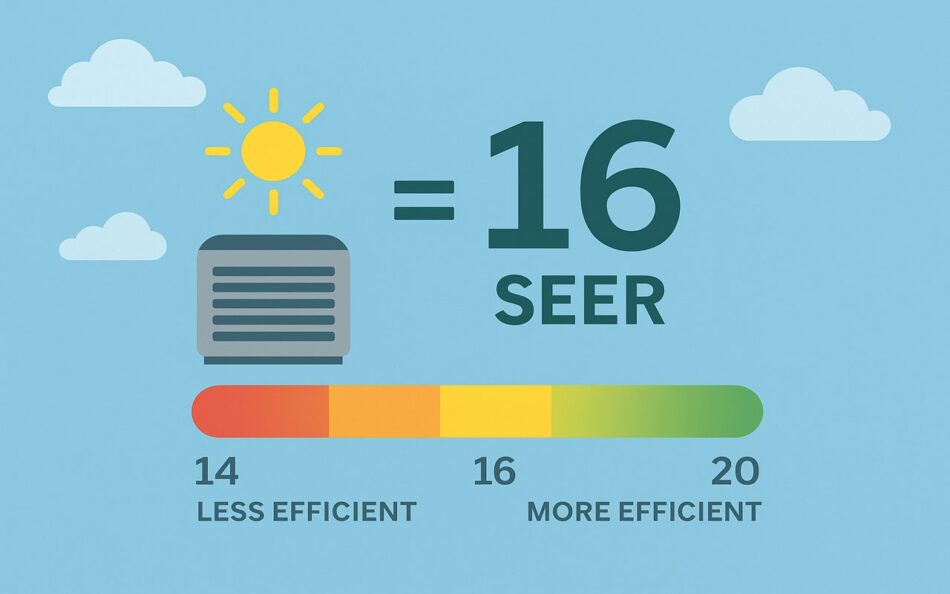SEER Rating Guide: What It Means for Your Energy Bills

When shopping for a new air conditioning system, one of the first things homeowners notice is the SEER rating on the label. While the number might seem like a confusing technical detail, understanding it can make a big difference for your comfort and your wallet. In Florida, where AC systems run nearly year round, the SEER rating guide is an important tool for anyone who wants to keep energy bills under control and enjoy reliable cooling. In this post, we break down what SEER really means, how it affects your electricity costs, and why it should matter to every Florida homeowner planning to upgrade or replace their AC system.
What Is a SEER Rating?
SEER stands for Seasonal Energy Efficiency Ratio. It measures how efficiently an air conditioning system operates over an entire cooling season. The higher the SEER rating, the more efficiently the system converts electricity into cooling power. In simple terms, a higher SEER means your AC can produce more cool air for each unit of energy it uses. While it might sound like a small difference on paper, over the course of Florida’s long hot season, the savings add up quickly. For example, moving from a SEER 10 system to a SEER 16 system can reduce your cooling costs by up to 40 percent.
Why SEER Ratings Matter in Florida
Florida homeowners rely on their air conditioning for many months each year. Between hot afternoons and high humidity, AC systems work harder and longer than in most other states. This extended usage means efficiency ratings like SEER have an even bigger impact on overall costs.
Older systems, especially those installed before the 2000s, often have SEER ratings as low as 8 or 10. These units use much more electricity to achieve the same comfort levels as newer, higher-SEER systems. If your system is older and your electric bills keep creeping up, the SEER rating could be the main reason. Upgrading to a modern system with a higher SEER rating not only saves you money but also improves your indoor comfort. Newer units operate more smoothly, run quieter, and better control indoor humidity.
How SEER Affects Your Energy Bills
Your energy bill is directly tied to how much power your AC consumes. A low-SEER system runs longer and uses more electricity to maintain the same indoor temperature. In contrast, a high-SEER system cools more efficiently and can often maintain your desired comfort level while using much less energy.
Let’s consider a typical Florida homeowner who spends about $200 per month on electricity during the peak summer months, with roughly half of that going to cooling costs. If you upgrade from a SEER 10 system to a SEER 16 system, you could save around 30 to 40 percent on cooling costs alone. That could mean monthly savings of $30 to $40 during the hottest months, adding up to hundreds of dollars each year. These savings can help offset the higher upfront cost of a new system, making the investment worthwhile over time.
Minimum SEER Requirements in Florida
The Department of Energy sets minimum SEER requirements for air conditioners sold in different parts of the country. In Florida and other southern states, the current minimum standard is SEER 15 for new central air systems.
If you are replacing an older system, you might find that your current unit falls well below this minimum. While it might seem like your old AC is still working fine, the difference in efficiency and comfort can be significant once you make the upgrade.
Balancing SEER Ratings and Upfront Costs
Choosing an AC system is not just about picking the highest SEER rating available. While higher SEER systems are more efficient, they also tend to be more expensive upfront. Homeowners should balance initial costs with long-term savings and comfort benefits.
In many Florida homes, a SEER rating between 16 and 18 offers a strong balance of efficiency and affordability. These systems provide excellent energy savings without a massive price increase compared to lower SEER models. If your budget allows, even higher SEER systems (20 and above) are available and can offer the highest levels of savings and comfort.
Consulting with an experienced HVAC professional can help you find the right balance for your home and financial goals. They can calculate your expected energy savings and help you determine how quickly you will recoup the initial investment.
Other Factors to Consider Alongside SEER
While SEER is a key efficiency metric, it is not the only thing that affects your comfort and energy bills. Other factors include the size and design of the system, your home’s insulation, window efficiency, and ductwork condition.
A properly sized system is crucial. An oversized or undersized AC can lead to uneven cooling, higher energy use, and reduced system lifespan, regardless of SEER. It is important to have a professional load calculation done to ensure your new system matches your home’s specific needs.
Variable speed and two-stage AC systems also improve comfort and efficiency by adjusting output to match real-time cooling demands. When combined with a higher SEER rating, these features can dramatically improve indoor comfort and energy savings.
Upgrade with Confidence: Trust Cusano Air
If you are considering a new air conditioning system and want to understand how the SEER rating guide can help you save on energy bills, the experts at Cusano Air Conditioning are ready to help. Our team will assess your home, explain your options clearly, and recommend the best system to match your comfort and efficiency goals.
Upgrading to a higher SEER system is not just about numbers on a label. It is about lower energy bills, better indoor air quality, and a more comfortable home all year long. Call us at 954-472-8002 or email cusanoair@yahoo.com today to schedule a consultation and start planning your upgrade with confidence.